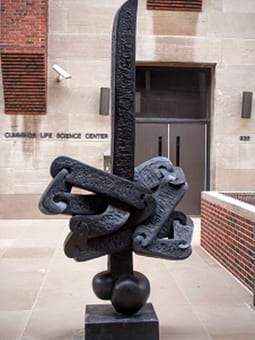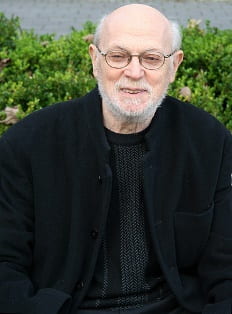Pulcinella II
Sorel Etrog (1933–2014)

Created 1965–1966
Installed 1978
Bronze
Height: 120 in. (304.8 cm)
Located in between Crerar Library and Cummings Life Science Center
920 E. 58th Street
Gifted to the University from the collection of Nathan Cummings
As you climb the stairs between the Crerar Library and Cummings Life Sciences Center, a bronze, sword–like figure begins to poke out over the brick of the stairwell. Installed in this spot in 1978 from the collection of Nathan Cummings, a major university donor, this sculpture is Sorel Etrog’s Pulcinella II. Inspired by the world of Commedia dell’Arte, a semi–improvised form of street performance that originated in 16th century Italy, Etrog drew on the servant character Pulcinella as the source material for this curious, comical piece.
Deep in the Italian countryside in his studio near Florence, Etrog began to work on the sketches that would become Pulcinella II in the mid–1960s. In these sketches, some found on the back of the invoice from the Florentine foundry he was closest to, the prominent, finger–like protrusion began to take form. Etrog seized on Pulcinella, one of Commedia’s classic stock characters, which are made recognizable by their inherent contradictions. Pulcinella is no exception—a generally lazy servant character, he flies into a fierce rage when provoked; he dreams far beyond his station and concocts crafty but impotent schemes to rise above it. The humor of Commedia was meant to appeal to the masses and frequently drew on some of the baser, more graphic tropes, and Etrog does not shy away from that aspect of the history. The sculpture’s present shape is the result of the fusion of a classical form of theater with a modern form of sculpture masterfully blended together in this cast bronze sculpture.
Sources
John J. Piva Jr., letter to William B. Cannon, July 11, 1977
Photos No.52.12.1-3 “Untitled,” c.1965; Period 4 1964/5-1967, Florence Studio; Documentation of Art Work; Sorel Etrog Fonds, Art Gallery of Ontario (Ontario, Canada)
Sketches No.29.1.1-3 “Untitled,” c.1965; Studies -Part 1; Preparatory and Experimental Works; Sorel Etrog Fonds, Art Gallery of Ontario (Ontario, Canada)
Further Reading
Rudlin, John. Commedia Dell’arte: An Actor’s Handbook. London: Routledge, 1994
Petterchak, Janice A. To Share: The Heritage, Legend, and Legacy of Nathan Cummings. Rochester, IL: Legacy Press, 2000

